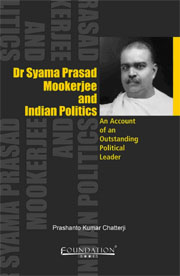Book contents
- Frontmatter
- Contents
- Preface
- 1 Dr Syama Prasad Mookerjee as the Finance Minister of Bengal, 1941–1942
- 2 Syama Prasad and Hindu Mahasabha's Ascendancy in Indian Politics, 1938–1944
- 3 Syama Prasad and Hindu Mahasabha's Transitory Resuscitation after Reverses, 1945–1947
- 4 Syama Prasad's Achievements as the Central Cabinet Minister, 1947–1950
- 5 Syama Prasad and Establishment of Bharatiya Jana Sangh, 1950–1953
- 6 Conclusion
- Appendix I
- Appendix II
- Appendix III
- Appendix IV
- Appendix V
- Appendix VI
- Appendix VII
- Bibliography
- Index
6 - Conclusion
Published online by Cambridge University Press: 05 February 2012
- Frontmatter
- Contents
- Preface
- 1 Dr Syama Prasad Mookerjee as the Finance Minister of Bengal, 1941–1942
- 2 Syama Prasad and Hindu Mahasabha's Ascendancy in Indian Politics, 1938–1944
- 3 Syama Prasad and Hindu Mahasabha's Transitory Resuscitation after Reverses, 1945–1947
- 4 Syama Prasad's Achievements as the Central Cabinet Minister, 1947–1950
- 5 Syama Prasad and Establishment of Bharatiya Jana Sangh, 1950–1953
- 6 Conclusion
- Appendix I
- Appendix II
- Appendix III
- Appendix IV
- Appendix V
- Appendix VI
- Appendix VII
- Bibliography
- Index
Summary
From the sphere of education, Dr Mookerjee moved to the realm of politics in 1938 when, following disagreement with the Congress policy to boycott the Legislature, he resigned and was re-elected as an independent candidate. From then onwards, he was actively involved in politics till his death in 1953. His struggle against the Muslim League in Bengal began with his opposition to the Secondary Education Bill that communalised education. He also found it necessary to protest against defilement of Hindu images, molestation of Hindu women and discrimination in government employment. In contrast, the Congress maintained a discreet silence on these issues, both in and outside the Legislative Assembly, lest a word against injustice or outrage on Hindus should offend Muslims. He, therefore, thought it necessary, in the wider interests of Bengal and India, to keep the Muslim League out of power by mustering together all the non-Congress Hindu forces in the Legislature. His efforts bore fruit first with the forming of the Progressive Coalition with the Krishak Praja Party under the leadership of Fazlul Haq's new coalition cabinet (12 December 1941) that included Dr Mookerjee as Finance Minister. A leading member of the Cabinet, Syama Prasad emerged as the new spokesman of the Hindu cause, inveighing against the communal policy followed by the previous Haq Ministry under the influence of its coalition partner, the League. However, referring to the Governor repeatedly pressing them to abandon Haq and to settle with the League, Dr Mookerjee confessed that working as a minister in such a situation was ‘a strange experience’.
- Type
- Chapter
- Information
- Dr Syama Prasad Mookerjee and Indian PoliticsAn Account of an Outstanding Political Leader, pp. 332 - 338Publisher: Foundation BooksPrint publication year: 2010

